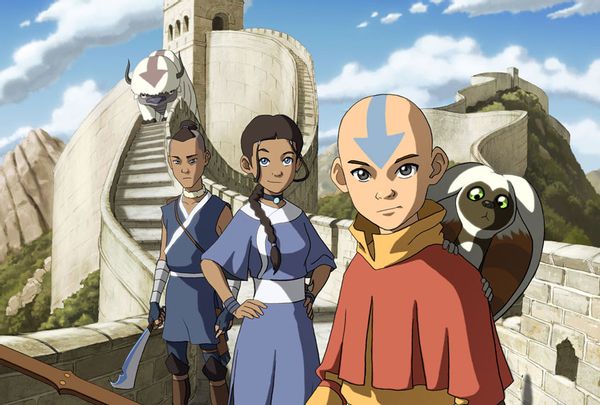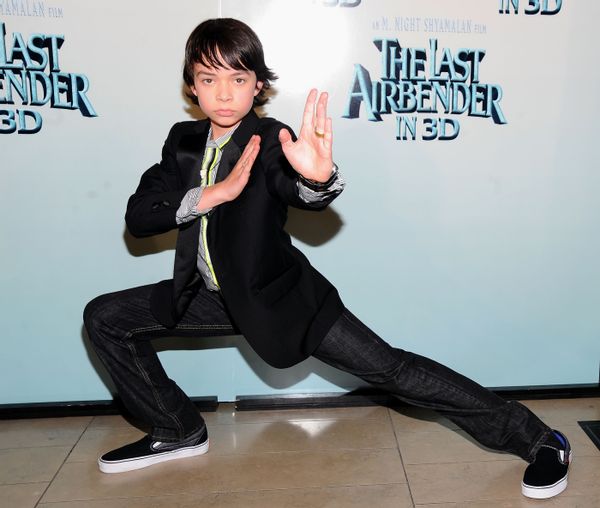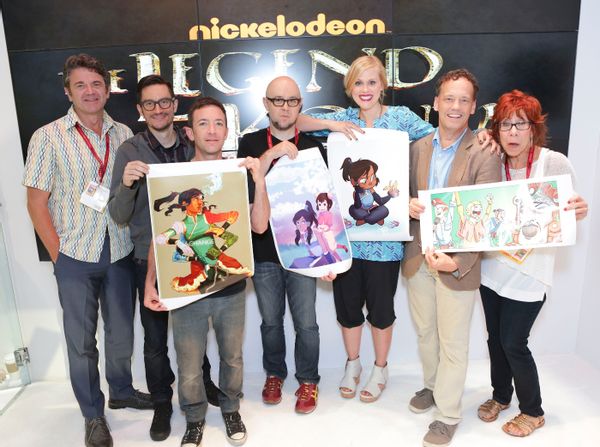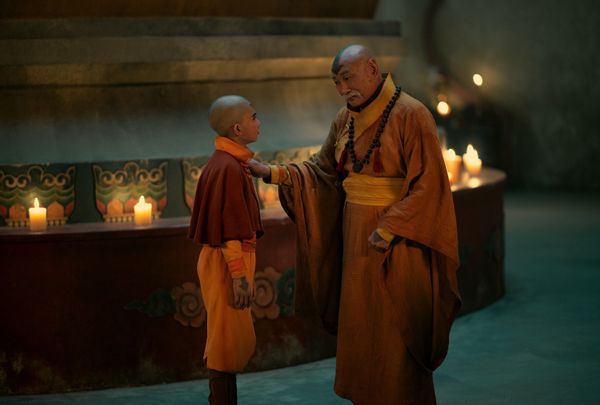
Long ago, the fandom of the hit children’s series “Avatar: The Last Airbender” lived in harmony, but everything changed when the impulse to expand the series attacked. Since the animated show ran on Nickelodeon from 2005 to 2008, the franchise has expanded to include the much derided M. Night Shyamalan live action movie adaptation “The Last Airbender”; the animated sequel to the TV series “The Legend of Korra”; and now, Netflix's live-action adaptation of the original series with Albert Kim as showrunner.
To understand why each new iteration has created such a furor, one must understand how it all began. In the original series, set in a fictional, vaguely Asian world that’s divided into four nations — Earth, Water, Fire, Air — gifted people in each nation can telekinetically “bend” one of these associated elements. Things are going great until one nation, Fire, decides to rule all others and eradicate the entire Air Nation save for one: the Aang who as the Avatar is destined to defeat the Fire Nation. The only problem: he’s vanished. The series begins 100 years after these events when siblings Katara and Sokka find Aang, who's mysteriously reappeared, and embark on a journey to defeat the enemy.
Originally created by Bryan Konietzko and Michael Dante DiMartino children, “Avatar,” remains revered across generations nearly 20 years after it first premiered due to its careful and deft portrayal of fighting fascism. It managed to be both nuanced enough to respect its subject matter but humanistic and empathetic to cater to its young audience. Salon’s senior critic Melanie McFarland once dubbed the Peabody- and Primetime Emmy-winning series the “purest portrayals of fighting facism on modern TV.”
Pure isn’t exactly how the new iteration can be described with Kim’s entry turning the dial up on violence. This may seem jarring to many fans of the series, but a closer examination of the various spin-offs shows that this is on trend for a franchise that continues to undermine the show’s original premise. To understand how to read this darker take on the show, it’s important to first trace how racial depictions and relations have evolved and broken down throughout the franchise.
The original series’ radically Asian world

The Asian influence felt even more impactful given the topic of colonialism. Many fans drew parallels between the imperialist Fire Nation and the Taishō Era in Japan, a time marked by increased militarization and industrialization driven by a desire to compete with and be reaffirmed by the West. This time is troubled by Japan’s colonalist enterprise to other Asian countries, similar to the Fire Nation’s intrusion upon the other Asian-eque nations. As Aang and friends embark on their odyssey visiting different tribes, they meet migrants, refugees, survivors: people who have all been affected by colonialism as the main characters have. They even encounter people who have more complicated relationships to this, like in Episode 42 when Aang learns that the Fire Nation children are taught a carefully manipulated version of history that mitigates and justifies their imperialist mission. Asiatic proximity isn’t just token aesthetics, but a meaningful lesson and layer to the show. The series, as The New York Times once described, “imagines a world free of whiteness.”
M. Night Shyamalan’s whitewashed movie

Not only does the movie whitewash the show, but it also does so in order to reaffirm racial binaries that white is good, while a person of color is to bad. Like Aang, the other heroic protagonists, Nichola Peltz’s Katara and Jackson Rathbone’s Sokka, are played by white actors despite the original characters being tan-skinned and of possibly Asian or Indigenous descent. The few times where Asian actors are allowed a part in the film are notably when they are the enemy, like main protagonist Admiral Zhao who is played by Indian and British actor Aasif Mandvi and Aang’s rival Zuko played by Dev Patel. Such biased representation like this reinforces stereotypes: white people are saviors, and people of color are either followers or antagonists . . . and in this case, ironically the colonialists. It's no wonder that the white savior character has lately been met with backlash. “Such a representation is used to demonstrate the inferiority of characters of color even within their own cultural contexts. There is a frequently used demonstration of superiority observable in Hollywood films, where the white character comes to possess enough skill, mastery, and recognition to displace his or her counterpart of color,” notes journalist R.P. Aditya for Offscreen.
Even when addressing criticism about the movie, Shyamalan first tried to spin this whitewashing as a triumph of cultural diversity. But he later admitted how white hierarchy undermined the filming process. He told The Hollywood Reporter, he “made a genuine effort to join the system,” but the Indian American director got “tired of the fight and having to defend who [they] are.” The whitewashing was heavily censured with Time calling the project the “worst epic movie ever made.”
The sequel’s series' abandonment of Asia

Instead, the distinctly American identifiers feel abrupt and incongruent. In the city, Korra (who is voiced by white actress Janet Varney despite her character being based on Inuit people) is the reincarnated version of the Avatar and moves to the city, spotting a statue of Aang in the style of the Statue of Liberty. In a series that established itself by creating Asian characters fighting colonialism, the choice to visually introduce Western aesthetics, the real-life symbols of colonialism, feels contradictory to the original’s premise. It also reveals the true colors of its creators, as it's undoubtedly a Western trait to assume that a progressing society looks like . . . America—even when that society was built on critiquing its entire enterprise.
It’s no wonder that “Legend of Korra'' succeeded in alienating the Asian fan base its predecessor built its fame on. “It is obvious now when comparing it with ‘The Last Airbender’ that it just stopped really using cultural shorthands from other cultures as part of its storytelling,” critic Jeanette Ng told Vox. “['Korra'] makes me think that all the things I liked about ‘Airbender’ happened accidentally. It’s a sequel that retroactively makes the work that came before worse, because now I think, ‘Oh, all the things I thought were good are just . . . [accidental].’”
The politics in “Korra” similarly feel antithetical to the first series'. The sequel begins with Korra mediating between mounting tensions over the inequality between people who can bend the elements and those who can’t. Thes story’s stance on the subject can be encapsulated by the tale of Wan who stole firebending abilities to feed his poor friends and family. The moral of the story isn’t that people should not have been left to struggle in the first place, but that Wan should not have taken the power that doesn’t belong to him. The end of the sequel sees Korra and friends restoring peace by establishing a democratic republic (read: America), thereby siding with the colonialists and their hierarchies.
The abandonment of Asian influences as well as the reinforcement of imperialist beliefs puts “Korra” at odds from the original. Beau Lee Gambold at PopMatters notes this disparity alongside the first series, saying, “While 'The Last Airbender' was nearly an anarchist meditation/fantasy about a way to be in the world, 'The Legend of Korra' is an example of how becoming mired in a capitalist system can inhibit your ability to imagine or to create.”
2024’s dark departure

Notably, the new version was initially created with Konietzko and DiMartino but the two exited the show due to creative differences, saying via a joint statement, “Netflix said that it was committed to honoring our vision for this retelling and to supporting us on creating the series. [. . .] Unfortunately, things did not go as we had hoped.”
This could in part be due to the series’ darker take on the original. The adaptation starts with a man being burned to a crisp by the Fire lord before beginning its nearly six-minute sequence depicting the eradication of the Air Nation. Though it isn't gory in a bloody sense, the scene does show the total destruction of the land and the burning to death of Aang’s mentor Gyatso (Lim Kay Siu). It ends on a petrified group of huddled children right before the Fire Nation soldier advances. At this point the scene cuts out yet implies their deaths.
The original series references these events but they are not depicted. Still, its consequences haunt the show through Aang’s flashbacks to his upbringing in the Air Nation, the mourning of the loss of Air Nation culture and knowledge, and the constant reminders that Aang is the last Airbender in existence. This created a powerful message considering the racial makeup of the character: as the Airbenders lifestyle was based on Tibetan traditions, many drew parallels of the massacre to the The Republic of China’s 1949 occupation of Tibet. At the core of the heartwarming show lurks an even deeper, more extreme theme: genocide.
Kim himself spoke about his decision to include explicit depictions of this harrowing, foundational event, telling Variety, “It wasn’t about aging it up. It was about setting the stakes for this world. One of the things we wanted to do was show how dangerous bending can be. Firebending should feel dangerous; it should feel [like] something that could hurt you.” The response misses the point of the original show: it’s not that firebending is evil, but that colonial fantasies, and specifically genocide, is. Nevermind the fact that Aang himself, as an Avatar who masters all four elements, also bends fire and has always bee empathetic to others that do, too.
Konietzko and DiMartino knew that audiences didn’t need to see violence to understand its trauma, which is why much of the series focuses on person-to-person relationships as Aang and friends traveled around and encountered people on the ground who are affected by colonialism in different ways, even citizens who are meant to profit off of it. This is especially true of the animated series' Zuko (voiced by Dante Basco), who begins the series as a staunch believer in the Fire Nation’s propaganda and superiority, a belief that often leaves him lonely, but ends the show realizing this is false. “They don’t see our greatness; they hate us, and we deserve it,” he says.

Certainly, this new iteration does not have to be nor should be a one-to-one adaptation, but the dark departure doesn’t serve the central critique of the show either. The focus of warfare’s violence rather than its traumas detracts from the original nuanced examination of expansionist endeavors, which was further poignant given the show’s more authentic – and now dissonant – depiction of an Asian and Indigenous world and people. Burning characters to cinders does little but to flatten colonialism into a fiery spectacle.
Furthermore, there’s something particularly cruel and ironic in watching the adaptation’s miscalculated violent portrayal of genocide while real genocide is currently being committed in Palestine. As the franchise continues to expand – with another upcoming series about the adult version of the original characters – the devolution of the show’s main premise reveals that critiquing genocide in a meaningful way may never have been the true intent of the show. Rather, it was a means of entertainment, a plot device and selling point for the capitalist industry. Just as America profits off of genocide, so too does the franchise as it makes spinoffs to capitalize on the original genocidal premise. Perhaps it's time once again for the Avatar to vanish.
"Avatar: The Last Airbender" is now streaming on Netflix.







